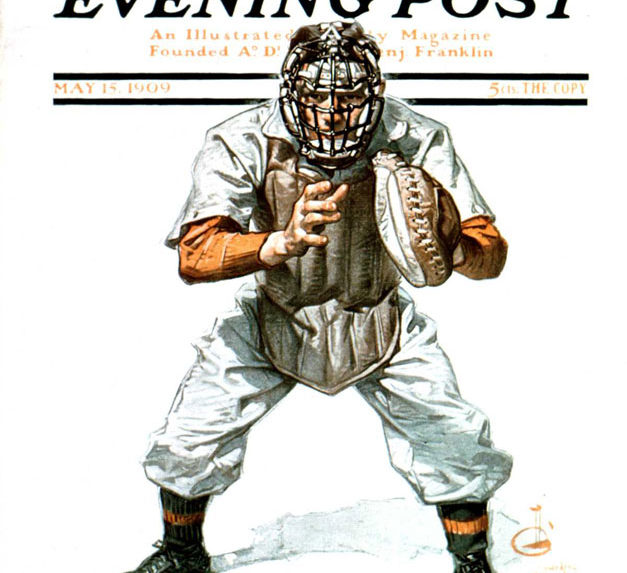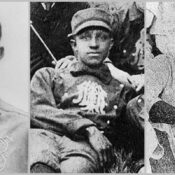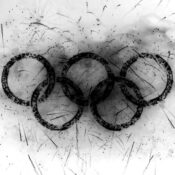When Major League Baseball’s All Stars take the field in July at Busch Stadium in St. Louis, thousands of fans will be thinking of Mel Ott and Eddie Joost instead of Derek Jeter and Albert Pujols. They’re keepers of the flame for teams alive only in sports history books and their own memories.
The New York Giants, Washington Senators, Boston Braves, St. Louis Browns—thousands of diamond enthusiasts still hold allegiance to these bygone teams. They organize fan clubs, celebrate great moments at meetings, and swap items on eBay every day all in the name of honoring the past of America’s pastime.
And their own youths.
Ron Gabriel grew up two miles from Ebbets Field, home of the Brooklyn Dodgers, at a time when you could hear radio announcer “Red” Barber’s play-by-play “from every open window in Brooklyn,” he recalls. These days Gabriel lives in Chevy Chase, Maryland, but Brooklyn never quite left the boy. On October 4, 1975, at 3:44 p.m., he formed the Brooklyn Dodgers Fan Club. It was 20 years to the minute of the team’s first and only World Series victory.
“I realized this intensity needed someone to bring [Dodgers fans] all together, to kind of act as a clearinghouse. I was confident I could do that.”
Gabriel hosted annual meetings at his home (serving hot dogs and Schaefer Beer, a longtime Dodgers’ sponsor). When the 50th anniversary of the team’s World Series victory rolled around in 2005, he organized a commemorative dinner and passed out bumper stickers: We Loved the Brooklyn Dodgers — and we still do!!
But for Gabriel and thousands of fans of Dem Bums, the world changed when the team moved to Los Angeles beginning with the 1958 season. “I went into a state of shock,
and I still am, still can’t believe it.” Diehards were devastated and many, like Gabriel, never transferred their allegiance to another team. “Once a Brooklyn fan, always a Brooklyn fan,” he says.
There is a common thread that binds fans of defunct teams, a certain poetry in their recollections that are valentines to the boys of summers past. You can hear it in the way they share stories —always in the present tense. Bobby Thompson hits the “shot heard round the world,” Willie Mays makes his magical over-the-shoulder catch. With each retelling, there are new insights, a deeper understanding. The drama of the game continues to unfold. Instant replays, never distant replays.
“We’re in the Twilight Zone,” says Bill Kent, founder of the New York Baseball Giants Nostalgia Society. “To us, the old Giants are still alive. We relive their exploits.”
Kent grew up in the Bronx, a trolley and subway ride away from the old Polo Grounds in upper Manhattan. As a youngster, Kent would sometimes sneak into the ballpark by climbing over the fence before crews arrived and stake out empty seats with his friends. Other times, he’d get picked to turn the turnstiles at the entrance gate, earning spare change and free admission to the game. It was a highly coveted role. “There were always more kids than jobs.”
The Giants society is a loosely knit group of baseball fans, lawyers, teachers, sports writers, and even “a lady umpire and a lady baseball player” among them, who participate in an online discussion group and get together three times a year for what Kent calls schmoozing. Three or four people showed up at the first meeting held at a Chinese restaurant. Word spread, and Kent had to find larger quarters at an Italian restaurant. These days, meetings attract upwards of 50 and are often held in a church basement. Ten dollars pays for the pizza. There are even a couple of Dodgers fans and a sprinkling of Mets fans. “We don’t care. We have nice people, and if they’re not nice, they’re out,” he says.
The 1950s was a turbulent decade for baseball fans. In 1953, the St. Louis Browns played their last game at Sportsman’s Park before moving to Baltimore. Brownies pitcher Ned Garver, who won 20 games for the 1951 team that ended with a 52-102 record, once famously said: “Our fans never booed us. They wouldn’t dare. We outnumbered ’em.” At least their legacy is alive and well. The St. Louis Browns Historical Society and Fan Club is celebrating its 25th anniversary this year.
In 1954, the Philadelphia Athletics moved to Kansas City; in 1953 the Boston Braves moved to Milwaukee. And, of course, there was the twin sting for New Yorkers in 1958 when both the Dodgers and Giants made their way to California.
When the Philadelphia Athletics moved to Kansas City starting with the 1955 season, it wasn’t a surprise. But that didn’t make it any easier for fans like Dave Jordan. “For a couple of years it was clear the A’s were running out of money,” he says. The city couldn’t support both the A’s and the Philadelphia Phillies. Still, Jordan says when the mayor announced a “Save the A’s” committee, “I was one of few people who took him seriously.”
Jordan is chairman of the board of the Philadelphia Athletics Historical Society in Hatboro, Pennsylvania, a robust organization of 800 members spread coast to coast. The society puts out a bimonthly newsletter, runs a museum, and holds functions to which original players are invited. There are a few younger members, but Jordan says that for the most part, its ranks are filled with people who were Shibe Park regulars in the days of Lefty Grove, Jimmie Foxx, Eddie Collins, and Mickey Cochrane. One of Jordan’s favorite ballpark memories was the 24-inning game against the Detroit Tigers on July 21, 1945, called due to darkness.
“I kept score for 22 innings until I ran out of space.” He donated that incomplete scorecard to the Philadelphia A’s Society Museum and Library.
When the team moved on to Kansas City, Jordan stayed a fan. “In 1955 and 1956 I went to Yankee Stadium when Kansas City was in town, but it wasn’t the same. They changed the numbers of quite a few players, and eventually I had to face the fact that the Phillies were what we had left.”
Middle-aged fans are now golden agers and elder statesmen. “That’s something we at the society think about,” Jordan says. “Until recently, we always had a big breakfast in the fall, selling out with hundreds of fans showing up.” But, he says, as volunteers get older, functions are being scaled back.
There are also fewer players alive who wore the uniform.
The repercussions are showing up in the sports memorabilia market. Mike Heffner, president of Lelands.com, the oldest and one of the largest sports memorabilia auction houses, says the 1980s and ’90s were the boom days in memorabilia of defunct teams. “In the past few years, we’ve noticed a slowdown. People who were following teams in the 1940s and ’50s are mostly retired, some have passed away, and their collections have been sold.”
Some team items are valuable not because of the passion of their fans but because of their scarcity. The Seattle Pilots, for instance, played one year in 1969 before becoming the Milwaukee Brewers. “They didn’t have a huge fan base. There aren’t a tremendous
amount of them out there. But a uniform patch or a team-signed ball is very rare, so it’s tremendously collectible,” Heffner says. The Colt .45s (1962-1964), a squad that became the Astros, “were a terrible team, but they had really neat uniforms with a pistol on the front, so they’re highly collectible.” The latest franchise to join the brotherhood of bygone teams is the Montreal Expos, now the Washington Nationals. But don’t look for big returns there. “Canada and baseball don’t go together that well,” Heffner says.
Of course, for fans it’s not about money and not even about memorabilia. Their teams may not be in the box scores, and the ballparks may long be gone, but the boys of summer never grow old.
Become a Saturday Evening Post member and enjoy unlimited access. Subscribe now




Comments
After that fine story, readers may want to join The NY Baseball Giants Nostalgia
Soc. Membership is free. Our meetings (schmoozings) are held 3X a year in NY,
and cost $10 incl. food.
We send out a plethora of stories about the old Giants (and some about the new)
to all members without charge.
Write to me at healthbul at msn dot com.
Cheers!
Bill
Fun stuff. I wonder if those teams that moved more than once (Braves – Boston to Milwaukee to Atlanta, for instance) picked up another fan club in the intermediate cities?
Hail to Iyna’s beautiful story!
My poem is in memoriam to Ron Gabriel, who passed away in Maryland last week.
I think that I shall never see/ Bobby Thomson spelled without a “p”/No one spells Branca with a “k”/ It makes me wish Thomson had K’d that day/If only that homer had left the park/ At the end of the bat of Alvin Dark/It might have been worse,the prospect wows me/ “Now batting Alex Konikowski.”
Wonderful piece! Makes me remember all those stories my father told of the glory days at the Polo Grounds. Thanks for the memories.
I applaud individuals like Ron Gabriel, Bill Kent, Dave Jordan and others for not just holding onto their fond memories but for being passionate enough to share them with others. They keep these great moments alive for new generations who weren’t as lucky as they were to experience things firsthand but can reap the benefits of their devotion to the teams and players. Wonderful story!
Thank you, Mr. Wingren, for a great catch. The Boston Braves did, indeed, move to Milwaukee in 1953. The team went on to win the World Series in 1957 against the New York Yankees in seven games. We regret the error. The correct date was immediately reflected on SaturdayEveningPost.com.
in 1957 the Boston Braves moved to Milwaukee
FALSE!!!
The Boston Braves moved to Milwaukee in 1953.
The MILWAUKEE Braves won the World Series in 1957 beating the Yankees.
A major error in the article calls into question the veracity of other information.